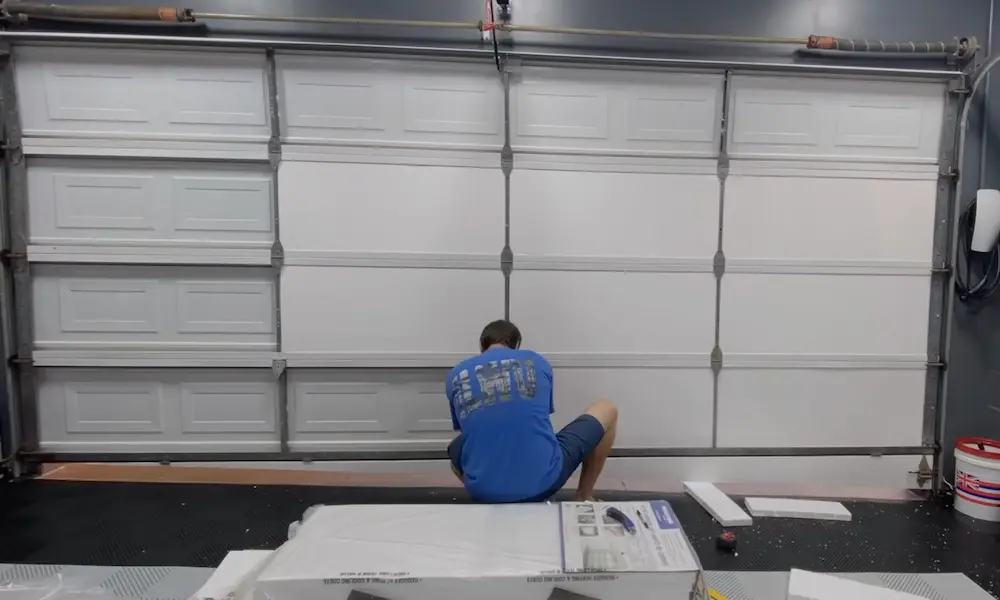You press that button on your mirror or sun visor, expecting your garage door to open smoothly. Instead? Nothing. Maybe a light flashes, but the door stays stubbornly shut. Before you throw your hands up and call for help, let’s walk through the real fixes that actually work for a HomeLink garage door opener not working.
Why Your HomeLink Stopped Working (The Real Reasons)
Most people think their HomeLink system is broken. Truth is, it’s usually just confused.
Your car talks to your garage door opener through radio signals. When something disrupts that conversation—whether it’s a protocol mismatch, interference, or a skipped setup step—your door won’t budge.
Here’s what actually causes the problem:
The opener and car speak different languages. Older cars struggle with newer security protocols, especially Security+ 2.0 systems that hit the market around 2011.
You trained it wrong. There’s a difference between “learned the signal” and “synchronized with the opener.” Miss that second step, and you’re stuck.
LED bulbs are jamming the signal. Cheap LED bulbs in your garage create radio frequency noise that drowns out your HomeLink signal.
Your remote’s battery is dying. Even if the little LED on your remote still lights up, a weak battery sends a garbled signal your car can’t copy.
Clear Your HomeLink Memory First
Before you do anything else, wipe your HomeLink’s memory clean. This is especially critical if you bought a used car or you’re reprogramming a button.
Hold down the two outer buttons (the first and third buttons) simultaneously. Keep holding—don’t let go yet. After 10 to 20 seconds, you’ll see the LED start flashing rapidly. That’s your signal to release.
This step is mandatory for Subaru, Volvo, and Polestar vehicles. Their systems won’t enter learn mode if the memory looks “dirty.”
Don’t release those buttons early. If you let go before the rapid flash, the memory doesn’t clear, and you’ll waste the next hour wondering why nothing works.
Understanding What That Blinking Light Means
Your HomeLink LED is trying to tell you something. Here’s the decoder:
| LED Behavior | What It Means | What You Need to Do |
|---|---|---|
| Slow blink | Ready to learn | Hold your garage remote 1-3 inches from the mirror |
| Rapid flash during training | Signal captured successfully | Move to the next step |
| Solid light after programming | Fixed code system (rare) | You’re done—test it |
| Rapid flash after programming | Rolling code system | You MUST press the learn button on your opener |
That last one trips up nearly everyone. If you see a rapid flash after training, you’re only halfway done. Your car learned the frequency, but it hasn’t synchronized with the garage door opener yet.
The Two-Part Programming Process
Part 1: Teaching Your Car the Signal
Replace the battery in your garage door remote. Yes, even if it still lights up. A dying battery might power the LED but can’t generate a clean radio signal.
Turn your car on (engine running or accessory mode—check your manual). Press and hold the HomeLink button you want to program. The LED will start blinking slowly.
Hold your garage remote 1-3 inches from the HomeLink buttons. Press and hold the remote button. Keep both buttons pressed until the HomeLink LED shifts from slow blinking to rapid flashing. This usually takes 10-30 seconds.
Release both buttons. Your car now knows the frequency.
Part 2: Syncing with the Opener (Rolling Codes Only)
If your LED is flashing rapidly, walk to your garage door opener motor (the box hanging from the ceiling). Look for the “Learn” button. The color matters:
LiftMaster/Chamberlain Learn Button Colors:
| Button Color | Frequency | Protocol | What It Means |
|---|---|---|---|
| Yellow | 310/315/390 MHz | Security+ 2.0 | Newest—may need a bridge |
| Purple | 315 MHz | Security+ 1.0 | Older rolling code |
| Orange/Red | 390 MHz | Security+ 1.0 | Mid-generation |
| Green | 390 MHz | Billion Code | Very old (1990s) |
Press and release the Learn button on your opener. You’ve got 30 seconds.
Run back to your car. Press and hold your programmed HomeLink button for 2 seconds, then release. Wait a beat. Press and hold again for 2 seconds. Release. Repeat this one more time.
Why three times? The first press sends the code. The second validates the encryption. The third actually moves the door. Don’t hold the button continuously—you need discrete presses.
The Security+ 2.0 Problem (Yellow Learn Button)
If your garage opener has a yellow Learn button and your car was built before 2013, there’s a good chance your HomeLink can’t physically talk to it.
Security+ 2.0 uses frequency hopping—jumping between 310, 315, and 390 MHz to defeat interference. Older HomeLink modules can’t replicate this pattern.
You’ll need a HomeLink Compatibility Bridge (LiftMaster model 855LM). It’s a translator box.
Plug the bridge into a garage outlet. Train your car to the small remote that comes with the bridge (don’t use your regular garage remote). Once your car learns the bridge remote, press the yellow Learn button on your opener and trigger your car’s HomeLink button three times.
Now the signal path works: Car → Bridge → Opener.
Heads up: The bridge needs power. If your electricity goes out, you can’t use HomeLink to open the door, even if your opener has battery backup.
Genie Openers: The Red vs. Green Trick
Genie remotes (like the G3T-R model) can transmit in two modes. A red LED means Intellicode 1. A green LED means Intellicode 2.
Most HomeLink systems struggle to clone the Intellicode 2 signal. The good news? The openers accept both.
Before training your car, switch your Genie remote to Intellicode 1 (red LED):
Hold the remote button for 10 seconds until both red and green LEDs light up. Press the button twice. Press once more to confirm the LED is now red. Now train your HomeLink using this simpler signal.
When syncing with the opener, press the square “PRGM” button on the motor unit. Look for a purple flashing LED (not blue—that’s a different mode). Press your car’s HomeLink button 3-4 times in quick succession.
LED Bulbs Are Killing Your Range
This one’s sneaky. You install LED bulbs in your garage to save energy. Suddenly, your remote only works when you’re practically touching the door.
Cheap LED bulbs use switching power supplies that spray radio interference across the 300 MHz range—right where garage openers operate.
The test: Unscrew your garage LED bulbs. Try your remote. If it suddenly works from the driveway again, you found your problem.
The fix: Replace them with shielded garage door opener bulbs (Genie LEDB1-R, LiftMaster 843LM, or similar brands). These have internal metal shielding that blocks the interference.
Don’t just grab any LED bulb. Regular household LEDs aren’t shielded. You need bulbs specifically designed for garage openers.
Car2U vs. HomeLink: Make Sure You Know Which One You Have
Between 2007 and 2013, GM and Ford installed a different system called Car2U in many vehicles. It looks similar but works completely differently.
How to tell:
- HomeLink (Gentex): One LED indicator, usually integrated into a house icon
- Car2U (Lear): Three separate LEDs, one above each button
If you have Car2U and you’re following HomeLink instructions, nothing will work. Car2U doesn’t “learn” the same way. It uses pre-programmed manufacturer codes and specific button sequences.
For Security+ 2.0 openers, Car2U systems need a special Car2U Repeater, not the standard HomeLink bridge.
Extending Your Range the Physical Way
Electronics work fine, but your HomeLink only opens the door when you’re two feet away? The issue is your garage door opener’s antenna.
That 9-inch wire hanging from your opener is a quarter-wave antenna. If it’s tucked inside the metal chassis or coiled up, it’s essentially deaf.
The coaxial extension fix works wonders:
Grab some RG-6 coaxial cable (TV cable). Connect the center conductor to the antenna terminal on your opener’s logic board. Run the cable along the ceiling and out through the header above the garage door. Strip back exactly 8.5 to 9 inches of the outer shielding at the exterior end, leaving the center conductor exposed.
This moves your antenna outside the metal box of your garage. Range jumps from 50 feet to over 200 feet.
Tesla-Specific Quirks
Tesla owners face unique challenges. The HomeLink transmitter isn’t in the mirror or overhead console—it’s in the front bumper area near the frunk.
When training, point your garage remote at the front Tesla emblem, not at the touchscreen. The screen just controls the system; it doesn’t receive the signal.
Tesla’s high-voltage electronics generate significant radio noise. Many Tesla drivers need the LiftMaster 855LM Compatibility Bridge even with relatively new openers just to overcome the car’s self-interference.
Follow the on-screen prompts carefully. When it says “step 2” or “synchronize,” you still need to physically walk to your opener and press the Learn button.
The Battery Paradox You Need to Know
Your garage remote’s LED lights up, so the battery must be fine, right? Wrong.
A dying CR2032 battery might have enough voltage (around 2.7V) to power the LED indicator but lack the current to drive the radio transmitter at full strength. The signal comes out weak and distorted.
Your garage opener, with its high-gain antenna tuned to the exact frequency, might still hear it. But your HomeLink module, using a broadband antenna that covers 288-433 MHz, needs a strong, clean signal to clone. A weak battery gives it garbage.
Replace the battery in your remote before attempting to program HomeLink. Every single time. It’s a two-dollar fix that solves half the “won’t program” complaints.
The Quick Diagnosis Checklist
Work through these in order:
- Replace your garage remote battery (even if the LED works)
- Clear your HomeLink memory (hold outer buttons for 20 seconds until rapid flash)
- Check if you have Car2U or HomeLink (one LED vs. three LEDs)
- Unscrew LED bulbs from your garage temporarily to test for interference
- Train your car to the remote (hold both buttons until rapid flash)
- Identify your opener’s Learn button color to determine the protocol
- Press the Learn button on your opener and trigger HomeLink 3 times (2-second hold each time)
- If it still fails with a yellow Learn button, get a Compatibility Bridge
Most HomeLink problems fall into predictable patterns. Yellow learn button openers need bridges for pre-2013 cars. Genie remotes need to be switched to red mode. LED bulbs need to be replaced with shielded versions. And everyone forgets to press that Learn button on the opener.
Work through the steps methodically. Don’t skip the memory clear. Don’t assume your remote battery is fine. And remember—if you see a rapid flash after training, you’re not done yet.
Your HomeLink garage door opener not working is usually a five-minute fix once you know which fix to apply. Now you do.















